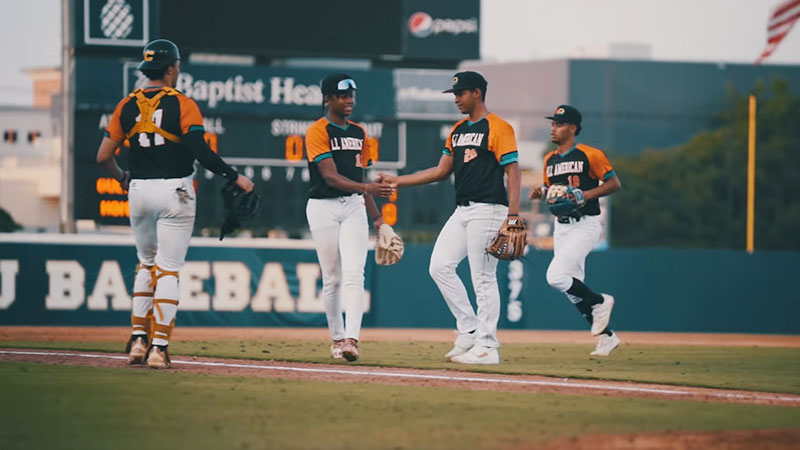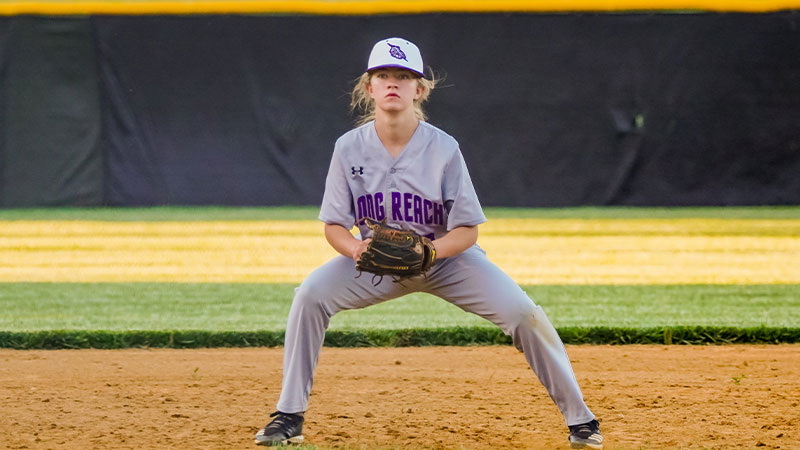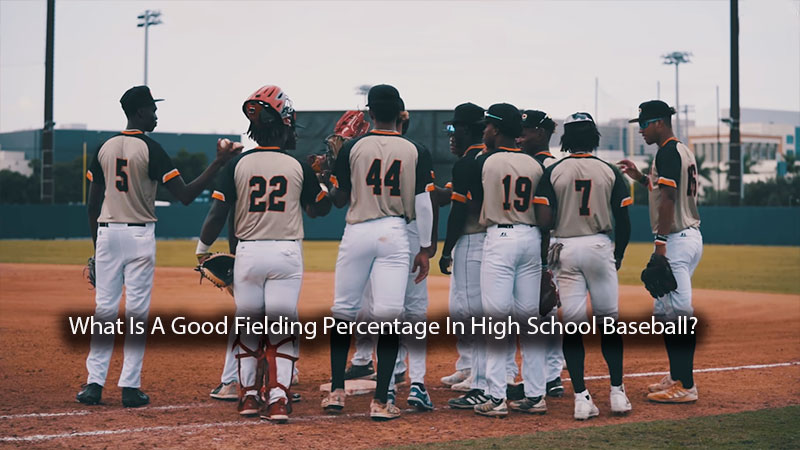High school baseball is a critical phase in a young athlete’s journey toward becoming a skilled and well-rounded player.
Fielding is a fundamental aspect of the game, and a player’s ability to excel in this area can be a game-changer. But what defines “good” fielding, particularly in the context of high school baseball?
In this blog post, we’ll explore the standards and expectations associated with fielding percentage in high school baseball.
We’ll delve into the nuances that affect this statistic, including position-specific differences and the varying levels of competition across different regions.
Understanding what constitutes a good fielding percentage can aid coaches, players, and parents in setting realistic benchmarks for skill development and performance.
Whether you’re an aspiring high school athlete, a coach looking to set targets, or a baseball enthusiast, this article will provide valuable insights into the metrics that matter on the field.
What Is FP Baseball Stat?
Fielding Percentage (FP), or Fielding Percentage, is a baseball statistic that measures a player’s effectiveness in fielding their defensive position. It is a simple and widely used statistic that calculates the ratio of successful defensive plays to opportunities.
The formula for calculating the Fielding Percentage is as follows:
Fielding Percentage (FP) = (Total Chances – Errors) / Total Chances
In this formula
“Total Chances” refers to the total number of defensive opportunities a player has had. This includes balls hit to them, grounders, fly balls, or any other defensive plays they were involved in.
“Errors” represents the number of mistakes or misplays a player made during those chances. Errors can include mishandled ground balls, dropped fly balls, throwing errors, and other defensive mistakes.
Fielding Percentage is typically expressed as a decimal number, with a perfect fielding percentage being 1.000, indicating that a player has made no errors in their defensive opportunities.
The closer a player’s fielding percentage is to 1.000, the more reliable and error-free their defensive performance is considered.
While Fielding Percentage provides a simple way to evaluate a player’s fielding skills, it has limitations, as it doesn’t take into account the difficulty of the plays a player is involved in or their range on the field.
More advanced defensive metrics like Ultimate Zone Rating (UZR) and Defensive Runs Saved (DRS) are often used to provide a more comprehensive evaluation of a player’s defensive abilities.
What Is a Good Fielding Percentage in High School Baseball?

In high school baseball, what constitutes a good fielding percentage can vary somewhat based on the level of competition, the position played, and the specific standards set by coaches and teams.
However, in general, a fielding percentage of .900 or higher is often considered good for high school players.
A fielding percentage of 1.000 (perfect) is the ideal goal, but it’s challenging to maintain over a full season, and some errors are inevitable.
It’s important to note that the quality of high school baseball can vary significantly from one region to another, so standards may differ.
Additionally, the fielding percentage should be considered in the context of the player’s position.
For example, infielders may have a slightly lower acceptable fielding percentage compared to outfielders because infield plays often involve quicker reactions and more difficult plays.
In any case, while fielding percentage is a useful statistic, it’s also essential to consider other factors like a player’s range, arm strength, ability to turn double plays, and overall defensive skills when evaluating their fielding abilities.
Coaches and scouts often assess a player’s defensive prowess through a combination of statistics and direct observations on the field.
Average Fielding Percentage by Position
The average fielding percentage in baseball can vary by position due to the different demands and difficulty levels associated with each position.
Here are approximate average fielding percentages by position at the Major League Baseball (MLB) level:
First Baseman
First basemen typically have the highest fielding percentages among all positions. An average fielding percentage for a first baseman might be around .995 to .997.
Second Baseman
Second basemen generally have good fielding percentages, with an average of around .985 to .990.
Shortstop
Shortstops are involved in many challenging defensive plays, so their fielding percentage can be a bit lower, averaging around .970 to .985.
Third Baseman
Third basemen handle a mix of routine and difficult plays. An average fielding percentage for a third baseman might be around .960 to .975.
Catcher
Catchers are evaluated differently, and their fielding percentage is only one part of their defensive contributions. An average fielding percentage for a catcher could be around .985 to .995.
Outfielders
The fielding percentage for outfielders can vary depending on factors like range, arm strength, and the difficulty of plays. On average, it might be around .980 to .990.
These are rough averages, and the actual fielding percentages for players at each position can vary widely based on their individual skills, playing conditions, and the specific level of competition.
Additionally, it’s essential to consider more advanced defensive metrics when assessing a player’s overall defensive abilities, as fielding percentage alone does not provide a complete picture of a player’s defensive performance.
Factors Affecting Fielding Percentage
A player’s fielding percentage in baseball can be influenced by various factors, and understanding these factors is important when evaluating a player’s defensive abilities.
Here are some of the key factors that can affect fielding percentage:
Skill Level
A player’s overall skill level, including their ability to track the ball, field it cleanly, and make accurate throws, plays a significant role in their fielding percentage.
Position
The position a player is assigned can affect their fielding percentage. Infielders often have a higher number of challenging plays, while first basemen tend to have a higher fielding percentage due to their involvement in routine plays.
Range
A player’s ability to cover ground and reach balls that are not hit directly to them (range) can impact their fielding percentage. Players with better range can make more plays and reduce errors.
Arm Strength and Accuracy
A strong and accurate throwing arm is crucial for infielders and outfielders alike. An accurate throw to the intended target can prevent throwing errors.
Field Conditions
The condition of the field, including the quality of the grass or turf and weather conditions, can affect a player’s ability to field the ball cleanly.
Ball Spin and Bounce
The way a ball spins or bounces can make fielding more challenging, as it can be unpredictable and difficult to handle.
Glove Quality
The quality and condition of a player’s glove can impact their ability to field the ball. A well-maintained and appropriately sized glove can make a difference.
Infield Surface
The type of infield surface (e.g., grass or artificial turf) can affect the way a ball plays and how it bounces, influencing a player’s fielding.
Mental Focus
A player’s mental state and concentration can impact their fielding performance. Lack of focus can lead to errors.
Experience
Players with more experience tend to have better fielding percentages as they have honed their skills and become more accustomed to the demands of their position.
Competition Level
The level of competition can influence fielding performance. Players may face different challenges and expectations in amateur, high school, college, and professional baseball.
Defensive Shifts
Modern baseball often employs defensive shifts, where fielders are positioned strategically to increase the likelihood of making plays. The effectiveness of these shifts can affect fielding percentages.
Defensive Metrics
Advanced defensive metrics like Ultimate Zone Rating (UZR) and Defensive Runs Saved (DRS) provide a more comprehensive evaluation of a player’s defensive contributions beyond fielding percentage.
It’s important to consider these factors and not rely solely on fielding percentage when evaluating a player’s defensive abilities.
Advanced defensive metrics and direct observation on the field are often used to provide a more complete picture of a player’s defensive performance.
Tips for Improving Fielding Percentage
Improving your fielding percentage in baseball requires practice, dedication, and attention to detail. Here are some tips to help you enhance your fielding skills and boost your fielding percentage:
Fundamentals and Technique

Focus on fundamental fielding techniques, including getting in a ready position, staying low, and keeping your glove down.
Work on proper footwork to get to the ball quickly and be in a good position to make plays. Practice catching the ball with soft hands to reduce the risk of errors.
Repetition
Consistent practice is essential. Repetition helps you become more comfortable with fielding situations and reduces errors due to nervousness or hesitation.
Work on fielding ground balls, fly balls, and line drives from various angles and positions on the field.
Reaction Time
Improve your reaction time by incorporating drills that challenge your quick reflexes, such as reaction ball drills or “hot box” drills.
Visualization
Mental preparation can be just as important as physical practice. Visualize successful plays in your mind before they happen to boost confidence.
Work on Your Footwork
Develop good footwork to get into the right position to field the ball. Practice your footwork for different types of plays (e.g., charging a slow roller, moving laterally, going back on a pop-up).
Throwing Accuracy
Strengthen your throwing arm and work on your throwing accuracy. Accurate throws can prevent errors on routine plays. Practice making quick, accurate throws to your target, whether it’s first base or another base.
Positional Specifics
Understand the specific demands of your position and practice plays and scenarios relevant to your role (e.g., double plays for middle infielders, fielding bunts for corner infielders).
Improve Your Range
Work on improving your range by increasing your speed and agility. Being able to reach balls outside your immediate vicinity can reduce errors.
Consistency
Consistency in practice and play is key. Strive for the same approach and technique every time you field the ball.
Stay Focused
Maintain concentration and stay focused on the ball throughout the play. Keep your eyes on the ball and anticipate its path.
Play in Different Conditions
Practice under various conditions, including different field surfaces, weather, and lighting, to become comfortable with different challenges.
Video Analysis
Record your practice sessions and games to review your fielding techniques and identify areas for improvement.
Seek Coaching
Consider working with a knowledgeable coach who can provide feedback and guidance on your fielding mechanics and strategy.
Game Situational Awareness
Develop a strong understanding of game situations and make quick decisions about where to throw the ball. Recognize when to hold the ball and when to make the throw.
Stay Positive and Learn from Mistakes
Understand that errors are part of the game. Stay positive and use mistakes as learning opportunities to improve your skills.
Remember that improving your fielding percentage takes time and effort.
Consistent practice, a commitment to refining your skills, and a focus on the details will contribute to better fielding performance and a higher fielding percentage.
FAQs
What’s a good fielding percentage in high school baseball!
A good fielding percentage in high school baseball is typically around .950 or higher, meaning a fielder successfully makes the play 95% of the time.
What is a good fielding percentage for high school baseball?
A good fielding percentage in high school baseball is generally considered to be above .950, demonstrating a strong ability to make routine plays consistently.
What is the FPCT baseball stat?
FPCT, or Fielding Percentage, is a baseball statistic that measures a player’s success in fielding. It is calculated as (Total Chances – Errors) / Total Chances and is usually expressed as a decimal, like .950.
What is a good fielding percentage for an outfielder in high school baseball?
A good fielding percentage for an outfielder in high school baseball is typically around .950 or higher, as they have fewer chances but need to make the most of them to excel defensively.
What is a good fielding percentage for youth baseball?
In youth baseball, a good fielding percentage is generally around .900 or higher. Coaches prioritize development, understanding that younger players may have a learning curve in mastering fielding skills.
Wrapping Up
A high school baseball player’s journey to improving their fielding percentage is a path marked by dedication, practice, and skill development.
This article has shed light on the standards for a “good” fielding percentage in high school baseball, which typically falls around .900 or higher, depending on the player’s position and regional factors.
However, it’s crucial to remember that fielding is not solely about statistics; it’s a dynamic and evolving skill that demands continuous practice and attention to detail.
As players and coaches work to achieve excellence, they should also focus on improving their range, arm strength, and overall defensive abilities.
By embracing a holistic approach to fielding, high school baseball athletes can become well-rounded contributors to their teams and position themselves for success on the diamond and beyond.







